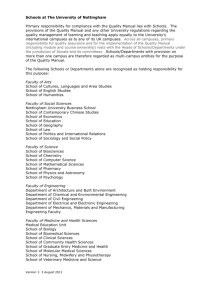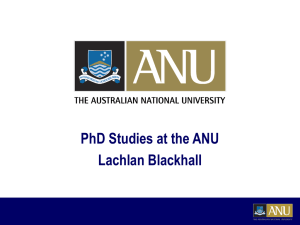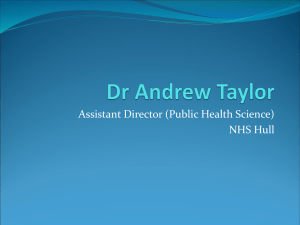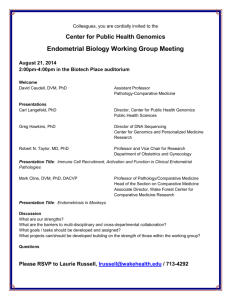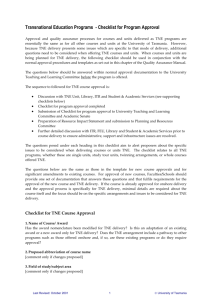PAPER ONE - University of Nottingham
advertisement
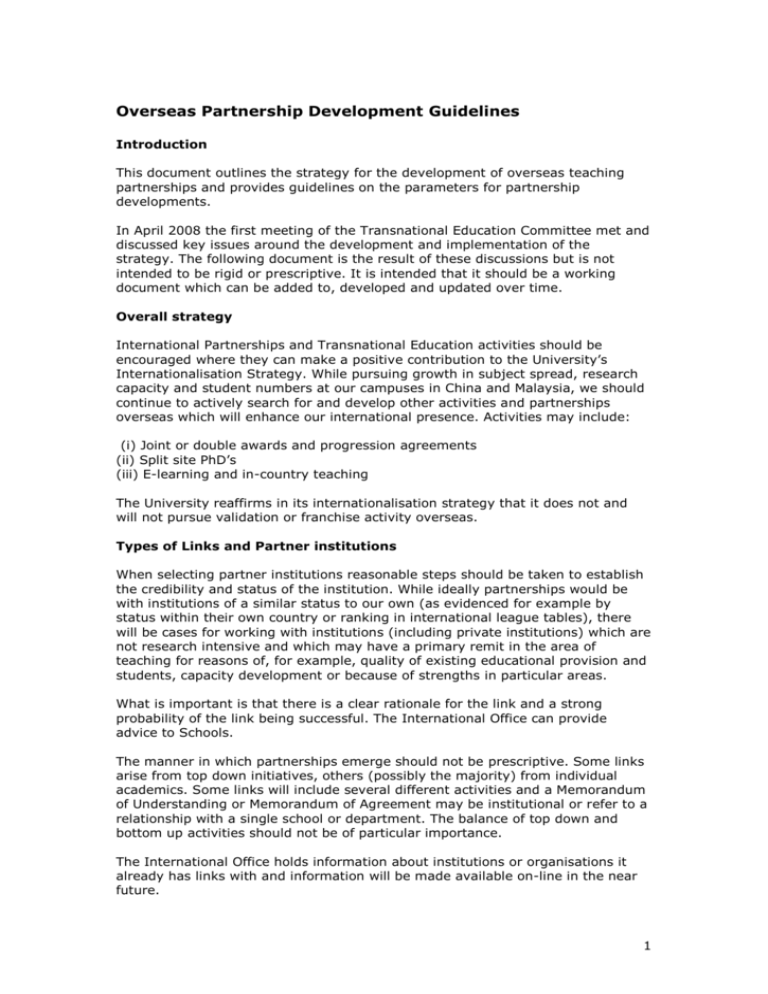
Overseas Partnership Development Guidelines Introduction This document outlines the strategy for the development of overseas teaching partnerships and provides guidelines on the parameters for partnership developments. In April 2008 the first meeting of the Transnational Education Committee met and discussed key issues around the development and implementation of the strategy. The following document is the result of these discussions but is not intended to be rigid or prescriptive. It is intended that it should be a working document which can be added to, developed and updated over time. Overall strategy International Partnerships and Transnational Education activities should be encouraged where they can make a positive contribution to the University’s Internationalisation Strategy. While pursuing growth in subject spread, research capacity and student numbers at our campuses in China and Malaysia, we should continue to actively search for and develop other activities and partnerships overseas which will enhance our international presence. Activities may include: (i) Joint or double awards and progression agreements (ii) Split site PhD’s (iii) E-learning and in-country teaching The University reaffirms in its internationalisation strategy that it does not and will not pursue validation or franchise activity overseas. Types of Links and Partner institutions When selecting partner institutions reasonable steps should be taken to establish the credibility and status of the institution. While ideally partnerships would be with institutions of a similar status to our own (as evidenced for example by status within their own country or ranking in international league tables), there will be cases for working with institutions (including private institutions) which are not research intensive and which may have a primary remit in the area of teaching for reasons of, for example, quality of existing educational provision and students, capacity development or because of strengths in particular areas. What is important is that there is a clear rationale for the link and a strong probability of the link being successful. The International Office can provide advice to Schools. The manner in which partnerships emerge should not be prescriptive. Some links arise from top down initiatives, others (possibly the majority) from individual academics. Some links will include several different activities and a Memorandum of Understanding or Memorandum of Agreement may be institutional or refer to a relationship with a single school or department. The balance of top down and bottom up activities should not be of particular importance. The International Office holds information about institutions or organisations it already has links with and information will be made available on-line in the near future. 1 The development of links may not just be confined to overseas universities. Links could be with: 1. 2. 3. 4. Private or public companies/bodies Charities Other UK universities Governments departments In choosing partners the impact of the relationship across all of the University’s campuses (UK, China and Malaysia) must be considered. Development of partnerships in China and Malaysia should be discussed with the relevant Provost/Vice-President. It is unlikely that TNE Committee would wish to approve links that are in direct competition with current or planned activity at either of the international campuses. Examples of the type of links which might be developed include: (i) Joint Degrees or dual degrees and progression agreements These programmes could include 2+2 degrees where the first 2 years are spent at an overseas institution and 2 years at any of our campuses. Other examples could be a 1+3 degree where the first year is a stand-alone foundation programme at an overseas institution. Possible masters twinning agreements could include partnering with institutions where a masters degree is taken over a 2-year period. Either year could be spent at Nottingham enabling the student to be awarded a stand alone masters degree from Nottingham and then for the student to count this as APL towards their 2year programme at the overseas institution. (ii) Split site PhD’s New schemes are being developed to enable students to register on a research degree at two separate institutions eg: Scheme 1: Academic Partner PhD This scheme is particularly aimed at partner academic institutions that want to up-skill their academic staff by investing in doctoral education. Students will register on a University of Nottingham PhD programme but most or all of their time will be spent at their overseas institution. The Programme The student will be registered at the UoN for their entire PhD. The scheme is for full time students only, when they are physically present in Nottingham A UoN based supervisor will be the primary supervisor and will have overall responsibility for the academic programme A local supervisor or mentor could be appointed to provide pastoral care, arrange access to facilities and academic expertise if appropriate Students will be charged 75% of the UoN fee across all 3 years When the student is at their base institution, supervision will be conducted by video conferencing and contact maintained by email and teleconferencing 2 On-line modules in teaching and learning in addition to on-line Graduate Training Scheme modules will be part of the package The maximum amount of time a student can spend at the UoN will be 1.5 yearso Scheme 2: International PhD Programme at the University of Nottingham The international PhD programme involves a link between two prestigious academic institutions to attract the best postgraduate researchers. Students will be awarded two PhD’s from two institutions. For supervisors, this would provide an opportunity to strength and deepen existing research collaborations and increase the number of cross-cultural and cross-disciplinary research groups. For students the programme would enable them to both access additional resources and give them international experience. The Programme Supervisors will be assigned at both locations Students will be registered full time at each institution The student will spend their study time between the two locations with the amount of time at each determined by their project, but with no more than two years spent at either institution Each institution will charge its fees at 50% of its normal rate for each year Supervision will be conducted by video conferencing and contact maintained by email and teleconferencing The scheme will be marketed to academics On-line Graduate Training Scheme modules will be available for students who register at the overseas institutions in their first year The Inter-Campus PhD Scheme is aimed at encouraging joint supervision of PhD students across University of Nottingham campuses in the UK, China or Malaysia. In the case of the China campus, students need to be registered at the UK campus until UNNC has been awarded a PhD licence. (iii) E-learning and in-country teaching Advances are now making it possible to use a variety of different technologies to deliver courses using the internet, interactive video conference facilities and WebCT. There are examples within the University where courses are being delivered using a mix of teaching modes or “blended learning”. The E-learning team can provide more information. Documents and Processes to Support TNE The Memorandum of Understanding is a document that is used when commencing discussions with partners. This is not a formal agreement but it symbolises that the universities intend to work together. The International database will record the agreements for the information of other university staff. MoU’s are signed by the Pro-Vice Chancellor International on the recommendation of the Director of the International Office. The Memorandum of Association, again, normally signed by the PVC for internationalisation if it concerns a teaching partnership, is the main, detailed 3 contractual document which outlines the rights and responsibilities of the institutions involved with the TNE activity. This must be used for all TNE activities and all should be formally approved by the MoA Approval Committee. In addition to this there is also a MoA Coversheet that provides a one page summary of the MoA. More information and templates for the documents can be found at http://www.nottingham.ac.uk/quality-manual/collaborative-provision/index.htm A business case should also be developed early on ensuring that net financial benefits of the link are achievable within a realistic period. For advice on business cases Schools should seek assistance from the School Financial Advisor. Geographical areas for Partnership Development The University will prioritise and possibly pump-prime activities in India and the Middle East (for the UK campus) where opportunities exist. However, this does not preclude activities anywhere else in the world. It may also be beneficial to schools to choose to develop partnerships in countries where active international student recruitment is taking place or where research relationships already exist. Regular visits by international office staff will provide additional support “on the ground”. Because of the availability of funding to support the development of links, Europe could also be a potential area for TNE activities. Some key questions for Schools to consider when considering geographical locations include. 1. 2. 3. 4. Is there evidence that there is a market for our courses? Can students in the country afford a UK education? Are there sound academic reasons for such a link in the particular country? How easy is it to do business in the country and how easy is it to travel there? 5. Are there any moral or ethical issues which may need to be considered? 6. Does the proposal fit with other strategic activities? Again, the International Office can provide advice. International Office Support The International Office will further support the development of links and provide the following services to support Schools. • • • • • • • • • Providing best practice documents and examples of successful links Help with market research Help with managing existing links in the set up phase and the initial period of operation Finding partners, sourcing opportunities Responding to incoming partnership development opportunities Pump priming through scholarships Admin Support in putting together MoA’s and implementation plans Liaison with the partners Help with promotion of links 4 • • • Development of a web site with helpful information Yearly Best Practice Seminars and other face to face dissemination activities Inviting outside speakers and arranging conferences on TNE (such as the Observatory conference in 2009 at the Malaysia campus) Targets and Milestones It is expected that the numbers of students entering the university through partnership agreements will increase by at least 70% over the next 3 years. 5
